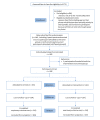An Intervention Delivered by Mobile Phone Instant Messaging to Increase Acceptability and Use of Effective Contraception Among Young Women in Bolivia: Randomized Controlled Trial
- PMID: 32568092
- PMCID: PMC7338928
- DOI: 10.2196/14073
An Intervention Delivered by Mobile Phone Instant Messaging to Increase Acceptability and Use of Effective Contraception Among Young Women in Bolivia: Randomized Controlled Trial
Abstract
Background: Although the most effective methods of contraception are available in Bolivia, unmet need for contraception among women aged 15 to 19 years is estimated to be 38% (2008), and the adolescent fertility rate is 71 per 1000 women (2016). Mobile phones are a popular mode to deliver health behavior support. We developed a contraceptive behavioral intervention for young Bolivian women delivered by mobile phone and guided by behavioral science. The intervention consists of short instant messages sent through an app over 4 months.
Objective: This trial aimed to evaluate the effect of the intervention on young Bolivian women's use of and attitudes toward the effective contraceptive methods available in Bolivia.
Methods: This was a parallel group, individually randomized superiority trial with a 1:1 allocation ratio. Women were eligible if they were aged 16 to 24 years, owned a personal Android mobile phone, lived in La Paz or El Alto, reported an unmet need for contraception, and could read Spanish. The target sample size was 1310 participants. Participants allocated to the intervention had access to an app with standard family planning information and intervention messages. Participants allocated to the control group had access to the same app and control messages. Coprimary outcomes were use of effective contraception and acceptability of at least one method of effective contraception at 4 months. Secondary outcomes were use of effective contraception during the study, acceptability of the individual methods, service uptake, unintended pregnancy, and abortion. Process outcomes included knowledge, perceived norms, personal agency, and intention. Outcomes were analyzed using logistic and linear regression. We also asked participants about physical violence.
Results: A total of 640 participants were enrolled, and 67.0% (429) of them contributed follow-up data for the coprimary outcome, the use of effective contraception. There was no evidence that use differed between the groups (33% control vs 37% intervention; adjusted odds ratio [OR] 1.19, 95% CI 0.80 to 1.77; P=.40). There was a borderline significant effect regarding acceptability (63% control vs 72% intervention; adjusted OR 1.49, 95% CI 0.98 to 2.28; P=.06). There were no statistically significant differences in any of the secondary or process outcomes. The intervention dose received was low. In the control group, 2.8% (6/207) reported experiencing physical violence compared with 1.9% (4/202) in the intervention group (Fisher exact test P=.75).
Conclusions: This trial was unable to provide definitive conclusions regarding the effect of the intervention on use and acceptability of effective contraception because of under recruitment. Although we cannot strongly recommend implementation, the results suggest that it would be safe and may increase the acceptability of effective contraception if the intervention messages were offered alongside the download of the app.
Trial registration: ClinicalTrials.gov NCT02905526; https://clinicaltrials.gov/ct2/show/NCT02905526.
Keywords: Bolivia; cellphone; contraception; mobile phone; reproductive health; young adults.
©Ona L McCarthy, Carolina Aliaga, Maria Eugenia Torrico Palacios, Jhonny López Gallardo, Silvia Huaynoca, Baptiste Leurent, Phil Edwards, Melissa Palmer, Irrfan Ahamed, Caroline Free. Originally published in the Journal of Medical Internet Research (http://www.jmir.org), 22.06.2020.
Conflict of interest statement
Conflicts of Interest: None declared.
Figures
References
Publication types
MeSH terms
Associated data
LinkOut - more resources
Full Text Sources
Medical




